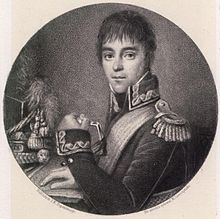Hamilkar from Rawicz-Kosinski
Hamilkar von Rawicz-Kosinski , actually Antoni Kosiński , but also: Hamilkar von Kosinski , Hamilcar Kosinski , Polish : Antoni Amilkar Kosiński or Antoni Amilkar Kosiński herbu Rawicz (born December 16, 1760 near Brześć in Podlachia ; † March 10, 1823 in Targowa Górka ) was a Polish division general , later a Prussian lieutenant general and most recently the commandant of the Posen Fortress .
Life
Origin and family
Antoni was a member of the Polish noble family Kosiński h. Rawicz . His parents were Józef Kosiński and Regina Korsak.
He first married Marcjanna Miładowska. This marriage ended in divorce in 1805. A second marriage took place in 1811 with Countess Adelheid Konstantia von Keyserlingk (1790-1856), the daughter of the general and court marshal Count Archibald von Keyserlingk on Targowa Górka and the Ernestine von Kalckreuth . Both marriages resulted in a total of three children:
- (exI) Józef Kosiński († 1813) fell as a lieutenant
- (exI) Ludwika Kosińska, ⚭ NN Kaczorowski
- (exII) Władysław Euzebiusz Kosiński (1814–1887), already sentenced to death for conspiracy in 1846, but converted to life imprisonment, released by the March Revolution in 1848, then participant in the Mierosławski uprising in 1848, ⚭ 1839 Emma Anna Węgierska h. Wieniawa (1818–1873), continue the tribe with five children.
Career
Kosinski was a pupil in the Piarist school until 1790 and leased the Ukrainian estate Zabłudowo from Karol Prozor (1759–1841) . He then joined the army in 1792 as a cadet in Lithuania . In the Kościuszko uprising , he fought as a captain and was wounded. With the dissolution of the Polish state in 1795 , he emigrated to France and served there in Nice in the navy in order to obtain French citizenship. It was only there that he took on the nickname Amilkar after the Carthaginian general Hamilkar Barkas .
During the first coalition , he served in the French army in Italy from 1795 . He took part in the Italian campaign as a colonel , adjutant general and chief of the general staff from 1797 under General Dąbrowski in the Polish legion . There he was captured in Austria for 11 months in 1799 . He was exiled with the Legion to Santo Domingo , but took his leave with the rank of Brigadier General in 1802 and returned to Poland in 1803. From 1806 to 1808 he fought again under Dąbrowski against Prussia during the fourth coalition . In 1809 he was governor of Warsaw . Although he took his leave again in 1811 as division general of the Veterans Corps, he was once again from July to December 1812 as commander of the reserve division to secure the bow line in the Polish army of the Principality of Warsaw . This also gave him an important role during the Russian campaign. Then he returned to his wife's estate in Targowa Górka.
Kosinski was a Freemason in the Loge Français et Polonais Réunis and since 1810 in the St. John's Lodge at the Temple of Unity in Poznan , which had been founded two years earlier and to which all of the city's Masonic lodges had been united; she belonged to the Great National Mother Lodge "To the Three Worlds" .
After the war he switched to Prussian service and in 1817 was promoted to lieutenant general. In 1820 he was transferred to the Poznan Fortress as the first commandant , but received his departure on October 25, 1820 with a pension of 1500 thalers, the payment of which was the subject of a long-standing dispute.
- Scoring in the Polish Biographical Dictionary (PSB)
Small in stature, very tough and assertive (energetic), well educated, open to his soldiers and farmers, but at the same time often strict and confrontational (even malice towards others) with an excess of ambition.
literature
- Polski Słownik Biograficzny , Volume XIV, pp. 208–215 u. 223-225
- Kurt von Priesdorff : Soldier leadership . Volume 4, Hanseatische Verlagsanstalt Hamburg, undated [Hamburg], undated [1937], DNB 367632799 , pp. 260-261, no. 1316.
- Juliusz Willaume: Amilkar Kosiński, 1769-1823 , Ostoja 1930 ( Polish )
- Leopold von Zedlitz-Neukirch : Pantheon of the Prussian Army , Berlin 1835, p. 233
Individual evidence
- ^ Leopold von Zedlitz-Neukirch : New Preussisches Adels-Lexicon , Volume 3, Leipzig 1837, p. 88.
- ^ Ernst Ludwig Posselt : Europäische Annalen , Volume 1, Tübingen 1804, p. 37.
- ^ Edward A. Foord: Napoleon's Russian campaign of 1812 , Boston 1915, p. 393.
- ↑ Manfred Laubert : Studies on the history of the province of Posen in the first half of the nineteenth century , Volume 1, Posen 1908, pp. 87-89.
| personal data | |
|---|---|
| SURNAME | Rawicz-Kosinski, Hamilkar von |
| ALTERNATIVE NAMES | Kosiński, Antoni; Kosinski, Amilkar; Kosinski, Hamilkar von; Kosinski, Hamilcar; Kosiński, Antoni Amilkar; Kosiński herbu Rawicz, Antoni Amilkar |
| BRIEF DESCRIPTION | Polish division general, Prussian lieutenant general, commander of the Posen Fortress |
| DATE OF BIRTH | December 16, 1760 |
| PLACE OF BIRTH | near Brześć , Podlaskie |
| DATE OF DEATH | March 10, 1823 |
| Place of death | Targowa Górka |
